Lyons W.C. (ed.). Standard handbook of petroleum and natural gas engineering.2001- Volume 1
Подождите немного. Документ загружается.

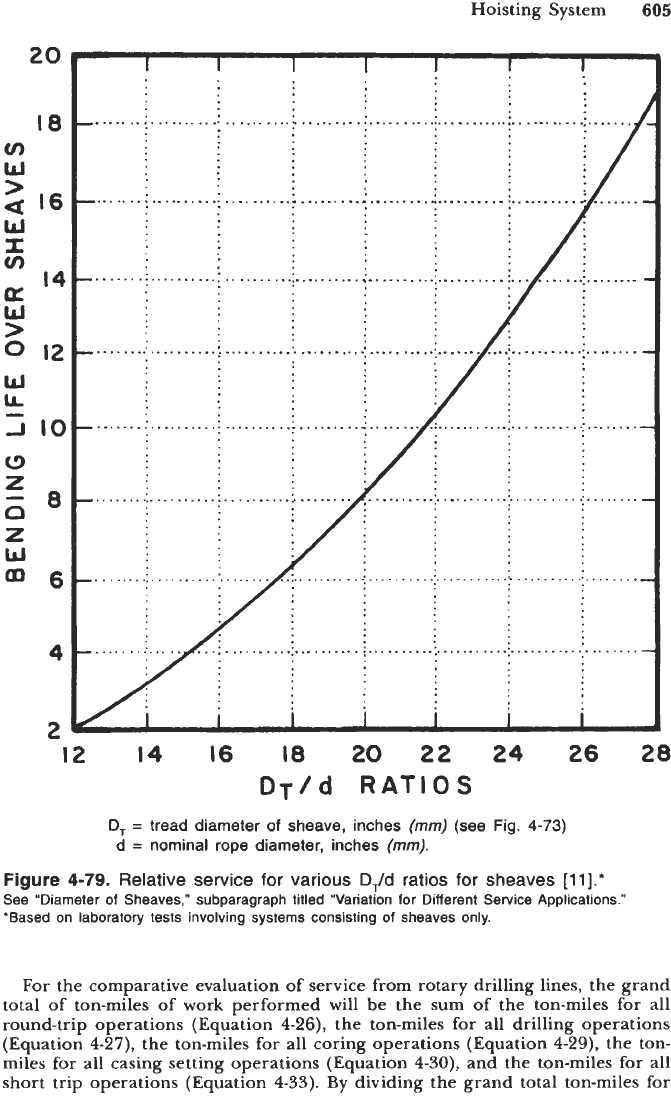
Hoisting System
605
20
18
tn
W
16
w
a
0
12
I
tn
W
>
W
LL
14
4
I I
I
1
I
I
I
12
14
16
18
20 22 24 26
28
DT/d
RATIOS
D,
=
tread diameter
of
sheave, inches
(mm)
(see Fig.
4-73)
d
=
nominal rope diameter, inches
(mm).
Figure
4-79.
Relative service for various
Dfd
ratios for sheaves
[ill.’
See “Diameter
of
Sheaves,” subparagraph titled ”Variation for Different Service Applications.”
‘Based on laboratory tests involving systems consisting
of
sheaves only.
For
the comparative evaluation of service from rotary drilling lines, the grand
total of ton-miles
of
work performed will be the sum of the ton-miles for all
round-trip operations (Equation
4-26),
the ton-miles for
all
drilling operations
(Equation
4-27),
the ton-miles for all coring operations (Equation
4-29),
the ton-
miles for all casing setting operations (Equation
4-30),
and the ton-miles
for
all
short trip operations (Equation
4-33).
By
dividing the grand total ton-miles for
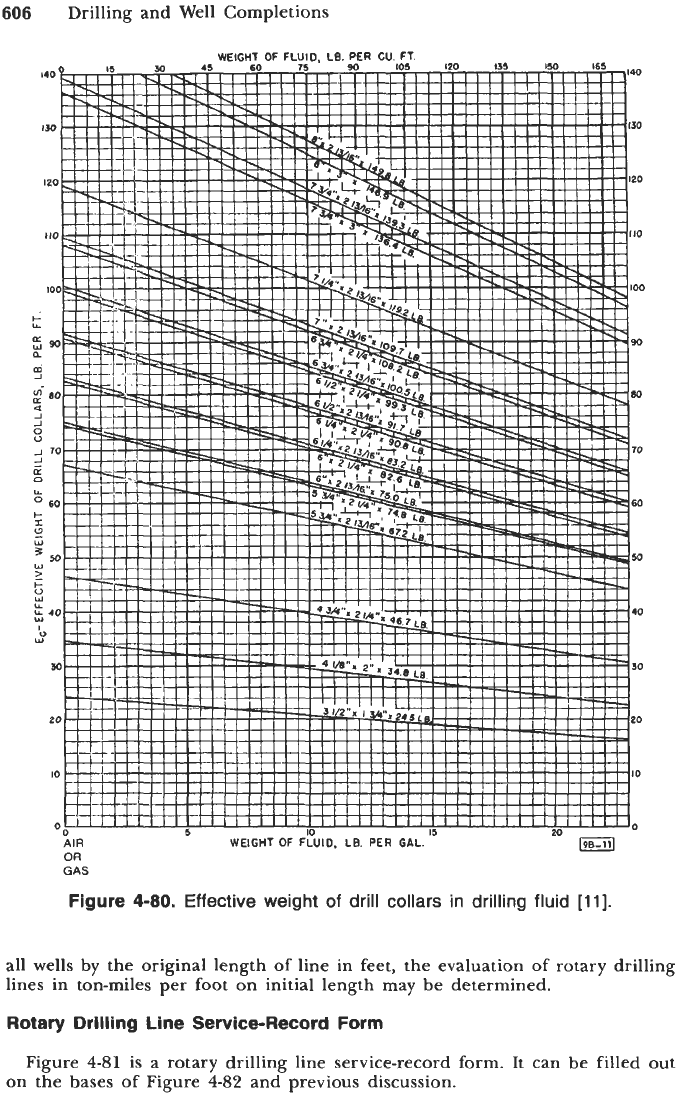
606
Drilling and Well Completions
WEIGHT
OF FLUID
LB.
PER
CU.
FT.
40
30
20
10
100
90
70
60
M
40
30
PO
10
I
II
IIIIlIllllllllllll1111111111111lIII
IO
20
AIR
WEIGHT
OF
FLUID,
LB.
PER
GAL.
198-111
OR
GAS
Figure
4-80.
Effective weight
of
drill
collars
in
drilling fluid
[ill.
all wells
by
the original length
of
line in feet, the evaluation of rotary drilling
lines in ton-miles per foot on initial length may be determined.
Rotary
Drilling Line Service-Record Form
Figure
4-81
is
a
rotary drilling line service-record form.
It
can be filled out
on the bases of Figure
4-82
and previous discussion.
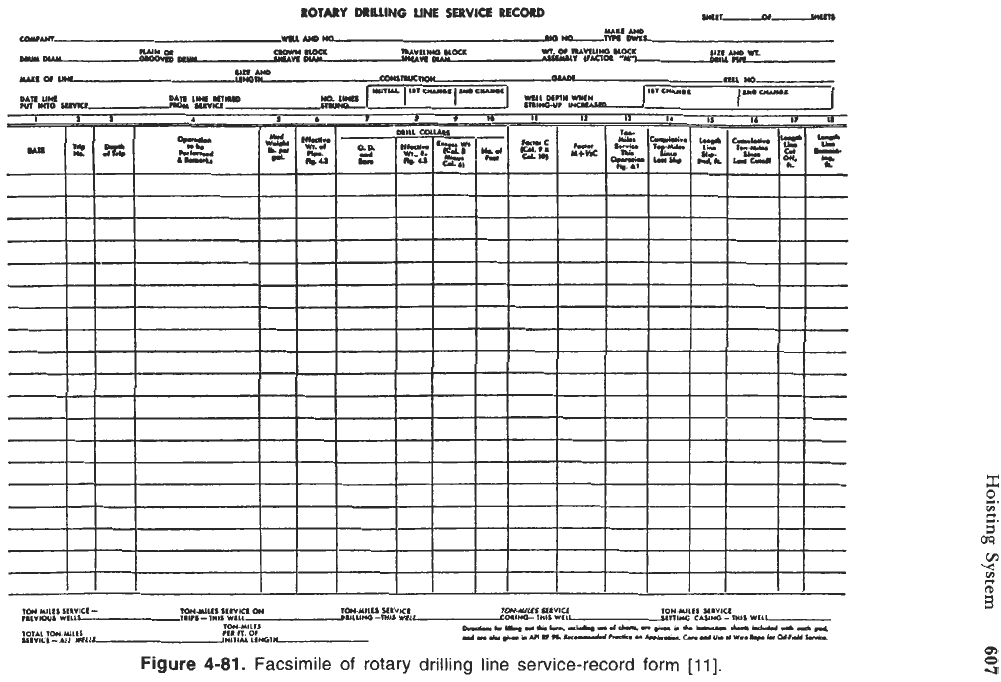
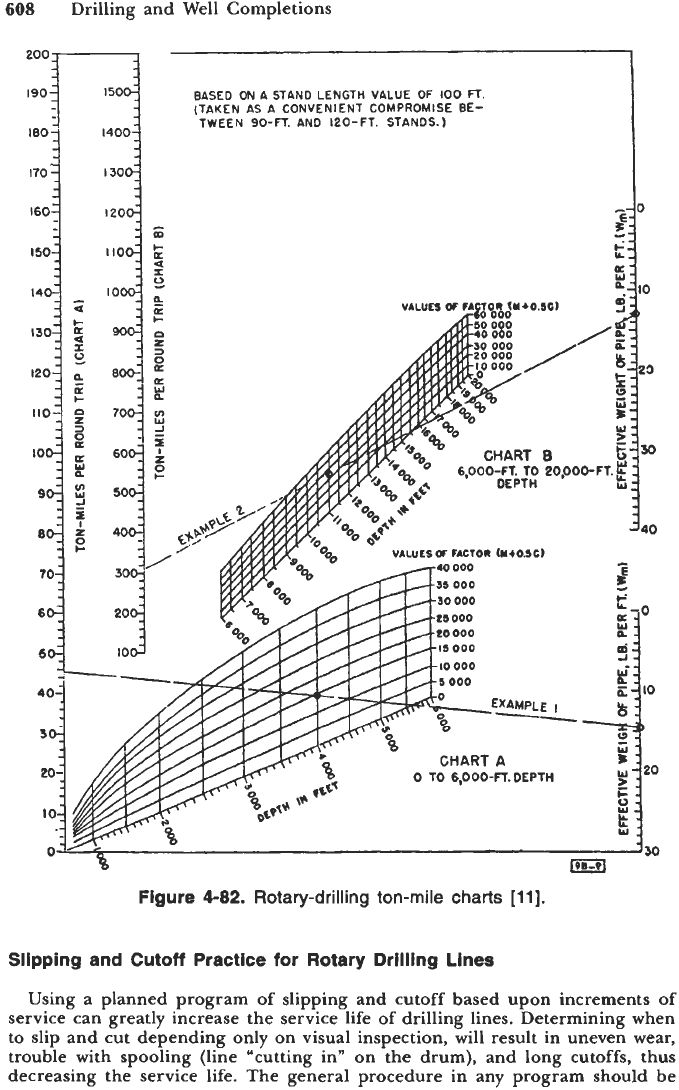
608
Drilling and Well Completions
BASED ON A STAND LENGTH
VALUE
OF
100
FT.
(TAKEN
AS
A
CONVENIENT
COMPROMISE
BE-
TWEEN
90-Fl.
ANO
120-FT. STANDS.)
c-
0
GZ
I
.E:
U,
VIWESQ
FACTOR
&toSC)
0
TO
6,000-Fl.OEPTH
Figure
4-82.
Rotary-drilling
ton-mile
charts
[ll].
Slipping and Cutoff Practice for Rotary Drilling Lines
Using a planned program of slipping and cutoff based upon increments of
service can greatly increase the service life
of
drilling lines. Determining when
to slip and cut depending only on visual inspection, will result in uneven wear,
trouble with spooling (line “cutting in” on the drum), and long cutoffs, thus
decreasing the service life. The general procedure in any program should be
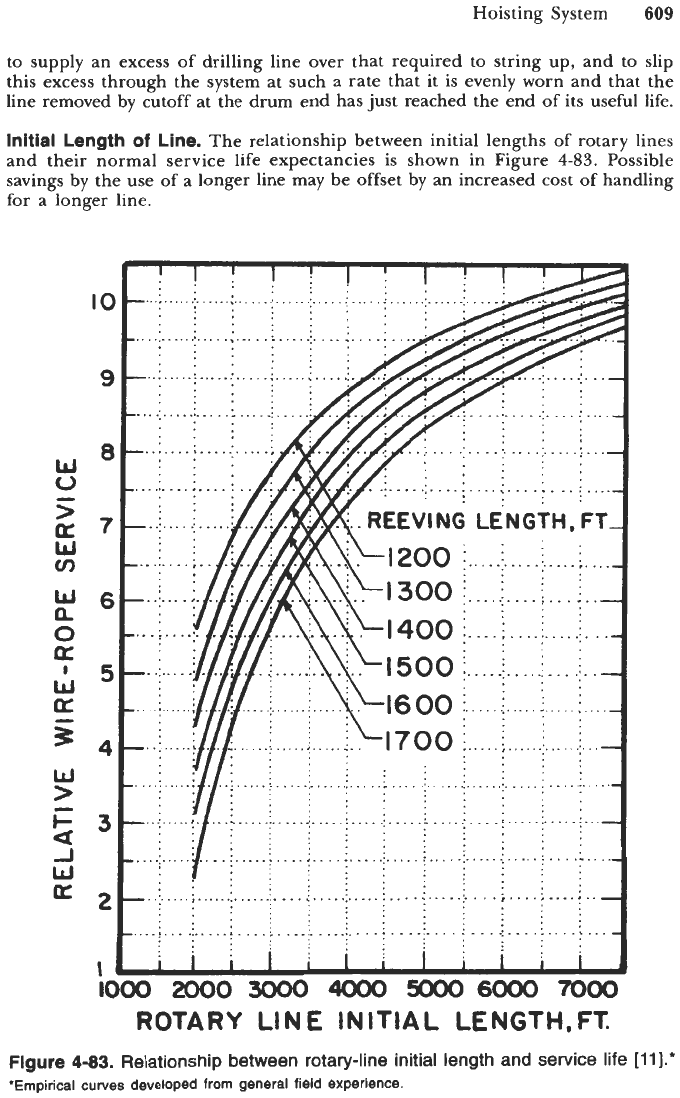
Hoisting System
609
to supply an excess of drilling line over that required to string up, and to slip
this excess through the system at such a rate that it is evenly worn and that the
line removed by cutoff at the drum end has just reached the end of its useful life.
Initial Length
of
Line.
The relationship between initial lengths of rotary lines
and their normal service life expectancies is shown in Figure
4-83.
Possible
savings by the use of a longer line may be offset by an increased cost of handling
for a longer line.
IC
9
a
w
c)
27
f6
W
v)
0
w
a
'5
a
-
34
w
>
53
w
a2
I
1000
2000
3000
4OOO
5OOO
6000
7000
ROTARY LINE INITIAL LENGTH,FT.
Figure
4-83.
Relationship between rotary-line initial length and service life
[11].*
*Empirical curves developed from general field experience.
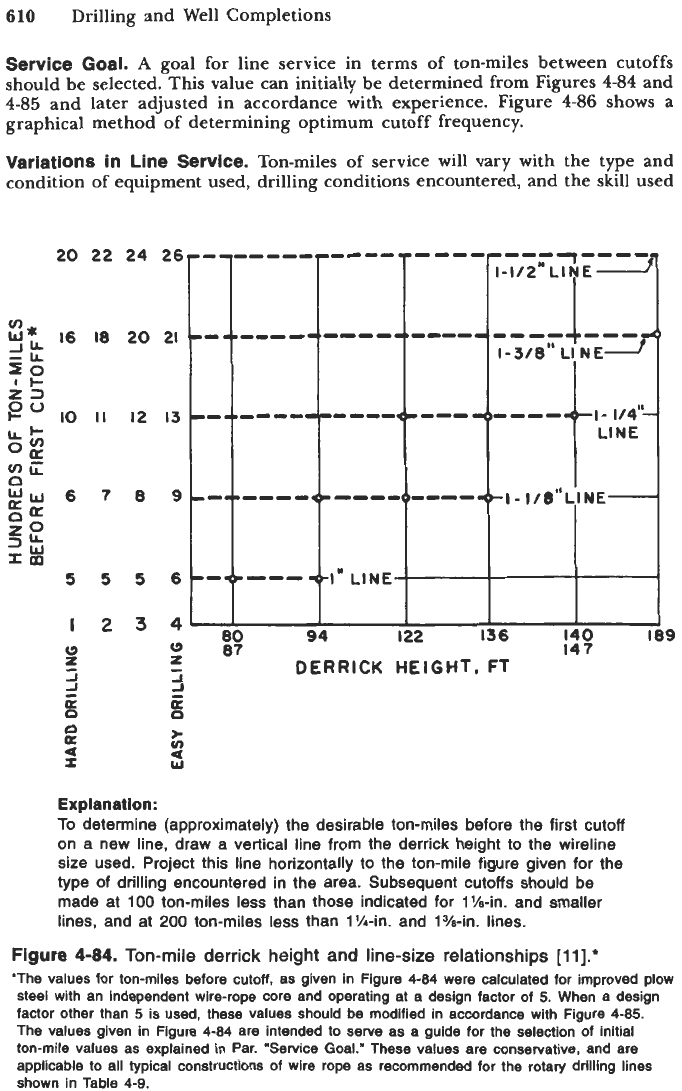
610
Drilling and Well Completions
Service Goal.
A
goal for line service in terms of ton-miles between cutoffs
should be selected. This value
can
initially be determined
from
Figures 4-84 and
4-85 and later adjusted in accordance with experience. Figure 4-86 shows a
graphical method of determining optimum cutoff frequency.
Variations in Line Service.
Ton-miles of service
will
vary with the type and
condition of equipment used, drilling conditions encountered, and the
skill
used
20
22
:*
I6
I8
24
20
I2
8
5
3
Explanation:
To
determine (approximately) the desirable ton-miles before the first cutoff
on a new line, draw a vertical line from the derrick height
to
the wireline
size used. Project this line horizontally to the ton-mile figure given for the
type
of drilling encountered in the area. Subsequent cutoffs should be
made at
100
ton-miles less than those indicated for 1Mn. and smaller
lines,
and
at
200
ton-miles less than 1%-in. and l%-in. lines.
Figure
4-84.
Ton-mile derrick height and line-size relationships
[l
l].*
"The
values for ton-miles before cutoff, as given in Figure
4-84
were calculated for improved plow
steel
with an independent wire-rope core and operating
at
a
design factor of
5.
When a design
factor other than
5
is used, these values should be modified
in
accordance with Figure
4-85.
The values given in Figure
4-84
are intended to
serve
as a guide
for
the selection of initial
ton-mile values as explained in Par. 'Service
Goal."
These values are conservative, and are
applicable to all typical constructions of wire rope as recommended
for
the rotary drilling lines
shown in Table
4-9.
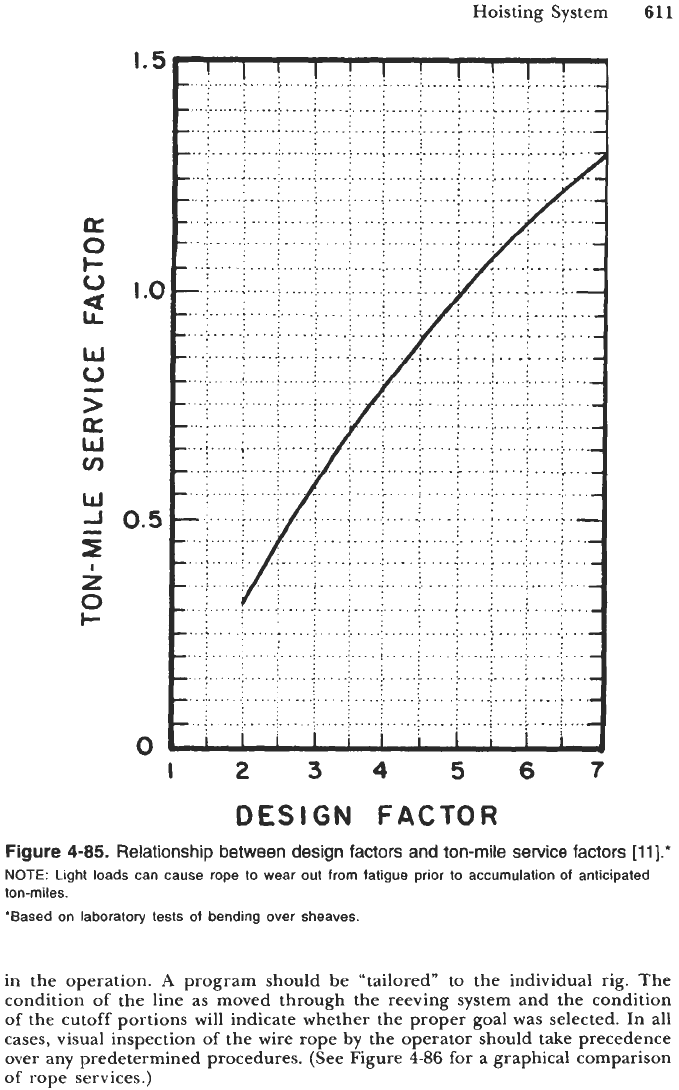
Hoisting System
611
I
2
34
5
6
7
DESIGN
FACTOR
Figure
4-85.
Relationship between design factors and ton-mile service
factors
[11].*
NOTE:
Light loads can cause rope to wear out
from
fatigue prior
to
accumulation
of
anticipated
ton-miles.
'Based on laboratory tests
of
bending over sheaves.
in the operation.
A
program should
be
"tailored" to the individual rig. The
condition of the line as moved through the reeving system and the condition
of
the cutoff portions will indicate whether the proper
goal
was selected. In all
cases, visual inspection of the wire rope
by
the operator should take precedence
over any predetermined procedures. (See Figure
4-86
for
a graphical comparison
of rope services.)
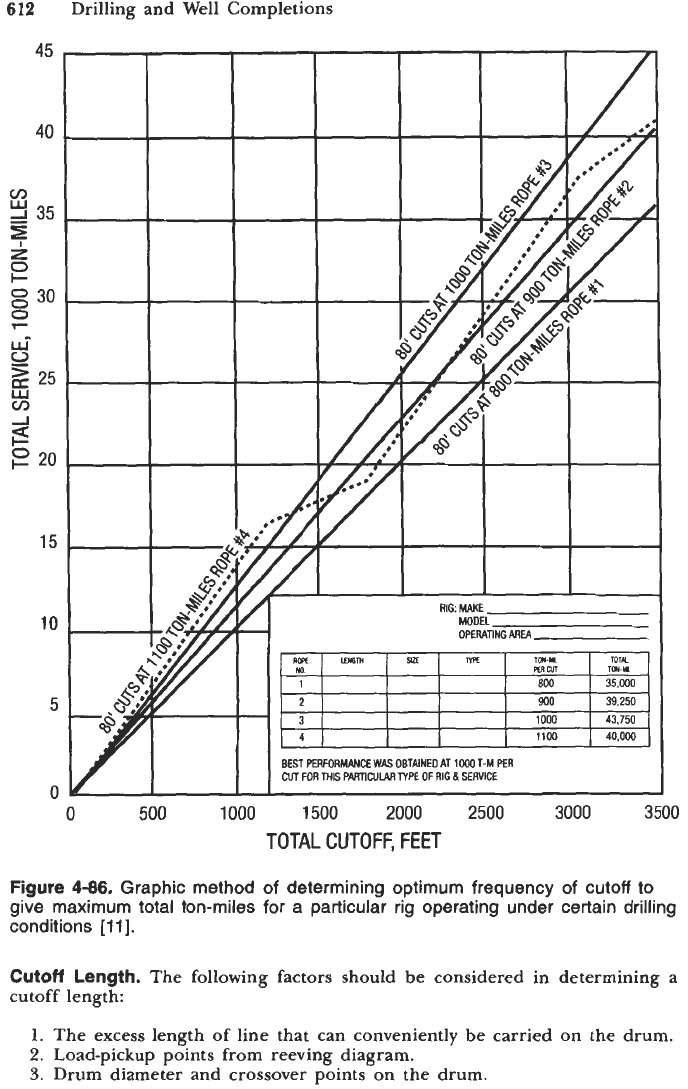
612
45
40
9
35
5
i
0
I-
0
8
30
u-
0
2
25
T-
Lu
CT)
$
g
20
15
10
5
0
Drilling and Well Completions
0
500
1000
1500
2000
2500
3000
3500
TOTAL CUTOFF, FEET
Figure
4-86,
Graphic method
of
determining optimum frequency of cutoff
to
give maximum total ton-miles for a particular rig operating under certain drilling
conditions
[ll].
Cutoff
Length. The following factors should be considered in determining a
cutoff length
1.
The excess length
of
line that can conveniently be carried
on
the
drum.
2.
Load-pickup points
from
reeving diagram.
3.
Drum
diameter and crossover points on the
drum.
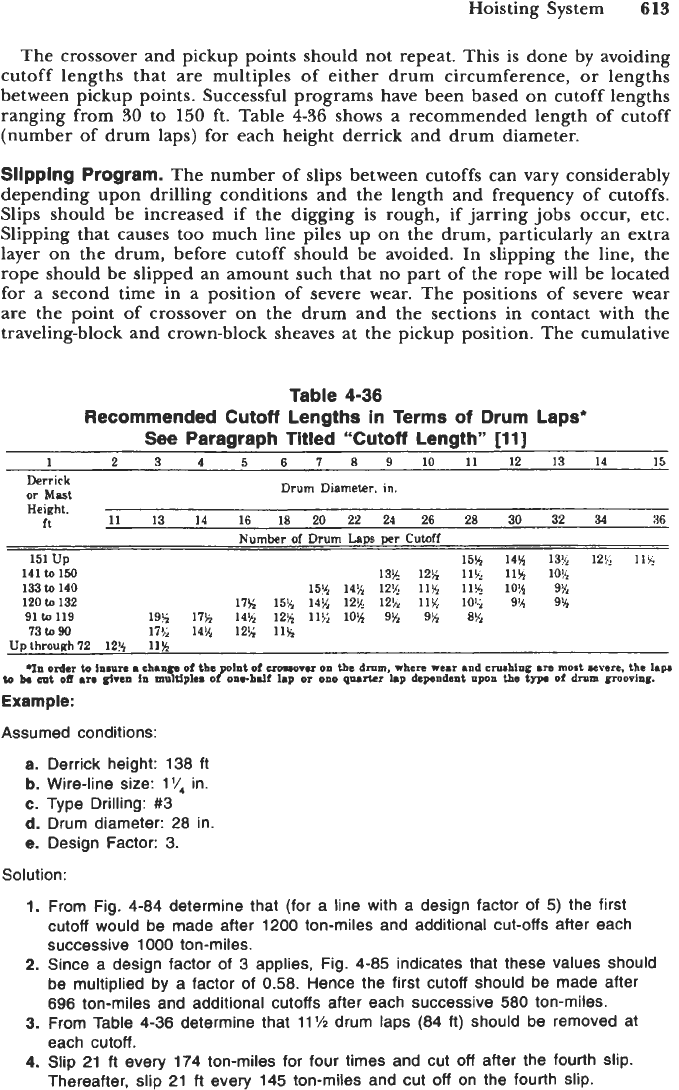
Hoisting System
613
The crossover and pickup points should not repeat. This is done by avoiding
cutoff lengths that are multiples of either drum circumference, or lengths
between pickup points. Successful programs have been based on cutoff lengths
ranging from
30
to
150
ft. Table
4-36
shows a recommended length of cutoff
(number of drum laps) for each height derrick and drum diameter.
Slipping Program.
The number of slips between cutoffs can vary considerably
depending upon drilling conditions and the length and frequency of cutoffs.
Slips should be increased if the digging
is
rough, if jarring jobs occur, etc.
Slipping that causes too much line piles up on the drum, particularly an extra
layer on the drum, before cutoff should be avoided. In slipping the line, the
rope should be slipped an amount such that no part of the rope will be located
for a second time in a position of severe wear. The positions of severe wear
are the point of crossover on the drum and the sections in contact with the
traveling-block and crown-block sheaves at the pickup position. The cumulative
Table
4-36
Recommended Cutoff Lengths in Terms
of
Drum Laps*
See
Paragraph Titled “Cutoff Length”
[11
J
1
2
3
4
567891011121314
15
Derrick
or
Mast
Drum Diameter.
in.
Height.
fl
11
13
14
16 18
20
22
24
26
28
30
32
34
86
Number
of
Drum
Laps
per Cutoff
151
Up
15!+ 14%
13%
12);
119:
141
to
150
13%
12%
ll!+
11%
10%
133
(0
I40 15% 14%
12%
11X
11%
10%
9%
120
to
132 17% 15%
14%
12%
12h
11%
10’4
9!4
9%
91
to
119
19%
17);
14%
12% 11%
10%
911,
9%
8!4
73(090
15%
14%
121;
11%
In
ode?
to
insure
a
cham
Oi
the
Uplhrouuh??
123
11%
1.t
Oi
ctol~~u
on
the
drum.
where
wear
and
cnuhlng
am most
mewre,
the
1.p.
to
b.
cut
oE
8n
ghen
in
multiplem
oP“,ehdf
lap
or
one
quarter
1.p
dependent
upon
the
trp.
of
drnm
moving.
Example:
Assumed conditions:
a. Derrick height:
138
ft
b.
Wire-line size:
1V4
in.
c. Type Drilling:
#3
d.
Drum diameter:
28
in.
e.
Design Factor:
3.
Solution:
1.
From Fig.
4-84
determine that (for a line with a design factor of
5)
the first
cutoff would be made after
1200
ton-miles and additional cut-offs after each
successive
1000
ton-miles.
2.
Since a design factor of
3
applies, Fig.
4-85
indicates that these values should
be multiplied by a factor of
0.58.
Hence the first cutoff should be made after
696
ton-miles and additional cutoffs after each successive
580
ton-miles.
3.
From Table
4-36
determine that
11%
drum laps
(84
ft) should be removed at
each cutoff.
4.
Slip
21
ft
every
174
ton-miles for four times and cut off after the fourth slip.
Thereafter, slip
21
fi
every
145
ton-miles and cut off on the fourth slip.
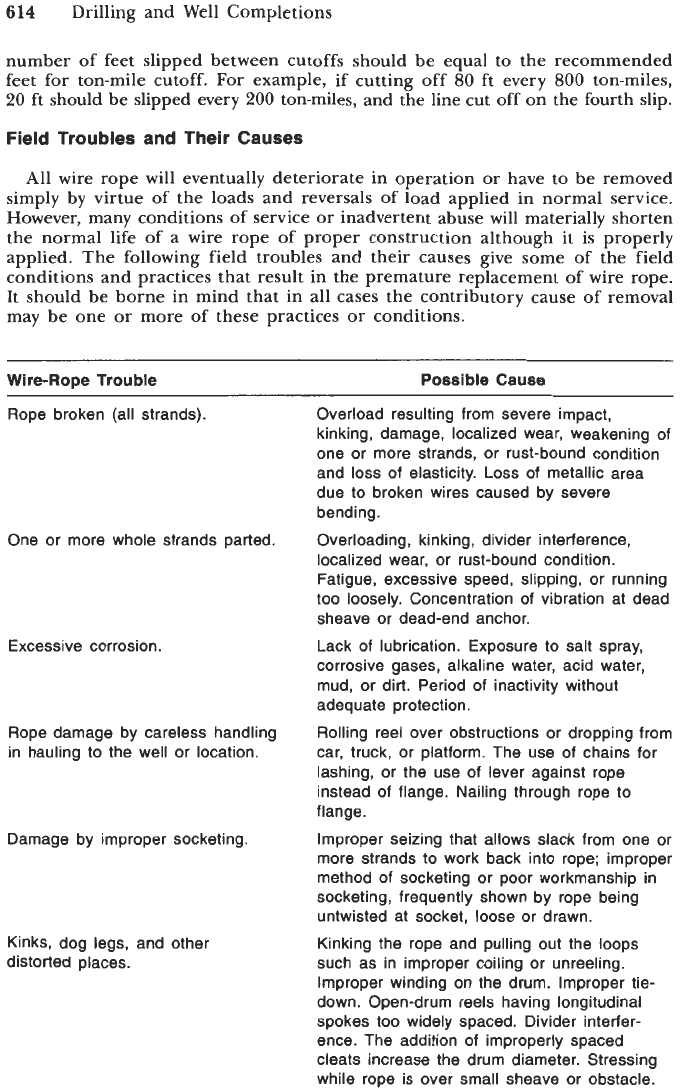
614
Drilling and Well Completions
number of feet slipped between cutoffs should be equal to the recommended
feet for ton-mile cutoff. For example,
if
cutting off
80
ft every
800
ton-miles,
20
ft
should be slipped every
200
ton-miles, and the line cut off
on
the fourth slip.
Field Troubles and Their Causes
All wire rope will eventually deteriorate in operation or have to be removed
simply by virtue of the loads and reversals of load applied in normal service.
However, many conditions of service or inadvertent abuse will materially shorten
the normal life of a wire rope of proper construction although it is properly
applied. The following field troubles and their causes give some of the field
conditions and practices that result in the premature replacement of wire rope.
It should be borne in mind that in all cases the contributory cause of removal
may be one or more of these practices
or
conditions.
Wire-Rope Trouble Possible Cause
Rope broken (all strands).
One or more whole strands parted.
Excessive corrosion.
Rope damage by careless handling
in hauling to the well or location.
Damage by improper socketing.
Kinks, dog legs, and other
distorted places.
Overload resulting from severe impact,
kinking, damage, localized wear, weakening of
one or more strands, or rust-bound condition
and
loss
of elasticity. Loss
of
metallic area
due to broken wires caused by severe
bending.
Overloading, kinking, divider interference,
localized wear, or rust-bound condition.
Fatigue, excessive speed, slipping, or running
too loosely. Concentration of vibration at dead
sheave or dead-end anchor.
Lack of lubrication. Exposure to salt spray,
corrosive gases, alkaline water, acid water,
mud, or dirt. Period
of
inactivity without
adequate protection.
Rolling reel over obstructions or dropping from
car, truck, or platform. The use
of
chains for
lashing, or the use of lever against rope
instead of flange. Nailing through rope to
flange.
Improper seizing that allows slack from one or
more strands to work back into rope; improper
method of socketing or poor workmanship in
socketing, frequently shown by rope being
untwisted at socket, loose or drawn.
Kinking the rope and pulling out the loops
such as in improper coiling or unreeling.
Improper winding on the drum. Improper tie-
down. Open-drum reels having longitudinal
spokes too widely spaced. Divider interfer-
ence. The addition of improperly spaced
cleats increase the drum diameter. Stressing
while rope is over small sheave or obstacle.
